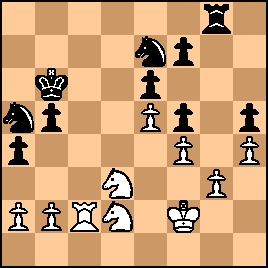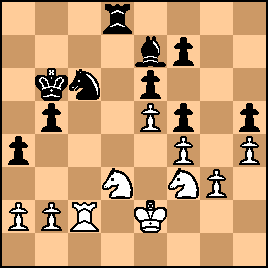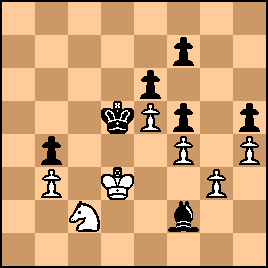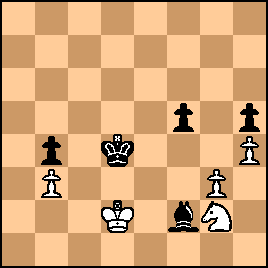Jul-25-22
 | | KEG: A long game that seemed headed for a draw that suddenly became a win for Kashdan when Bernstein blundered on his 64th move. In effect, this game is about that one move.
But the game is nonetheless important in two respects. First, it demonstrates just how tricky even simple looking minor piece endings can be. At the time of Bernstein's losing blunder, he had a drawn Knight and three pawns against Bishop and three pawns ending. It looks easy, but--as Bernstein's mistake reminds us--it is easy to go wrong. Second, Kashdan's efforts to win a clearly drawn ending--in part by wearing down his opponent--show that one can make progress by setting problems for one's opponent. In the theoretically drawn ending, Kashdan forced Bernstein to find saving moves. None were all that hard; but only one blunder was needed to change the result. Bernstein and Kashdan had both won their first-round games at this 1936 U.S.Championship. The day after this game, Bernstein registered the upset of the tournament by winning--as Black--the only game of his life against Samuel Reshevsky. That triumph might have been even sweeter for Bernstein if he had not thrown away this second-round game. 1. d4 d5
2. Nf6 c5
3. c4
So now, by transposition, we have a Queen's Gambit: 
click for larger view3... dxc4
Make that a Queen's Gambit Accepted.
4. Nc3 a6

click for larger viewNot quite an innovation. It had been played once before this game by Akiba Rubinstein in 1930 in a game he drew against Vera Menchik. With best play, White can secure a small edge. 5. dxc5
Menchik's 5. e4 is probably better, as are 5. d5 and 5. e3. The text allows a trade of Queens and seems drawish (and indeed this game looked like a draw until move 64). 5... QxQ+
6. KxQ
With Queens off, this recapture is probably better than retreating the Knight with 6. NxQ. The King in the center and the loss of the chance of castling is not of great significance for White here. White's lead in development at least compensates The position after 6. KxQ was:

click for larger view6... Nf6
7. Bg5

click for larger viewThis Pillsburyish move can be strong for White in some variations of the Queen's Gambit. With the Queens off the board, however, it serves little purpose. 7... e6
8. e3 Bxc5
9. Bxc4 b5
10. Bd3 Nbd7
11. Rc1

click for larger viewWith White's Bishop misplaced on g5, Black--is anyone--has the (slight) advantage. With matching pawn structures and neither side having any immediate attacking possibilities, the game already looked drawish. And after a few upcoming fits and starts, that will be the diagnosis until Bernstein's fatal move 64. |
|
Jul-25-22
 | | KEG: Post II
11... Bb7
As becomes clear from what follows, Kashdan was not satisfied with a draw. If he had been, he likely would have played 11...Be7 with a small edge. The text's only advantage is its attempt to unbalance the position. 12. BxN gxB
Better than 12...NxB 13. Nxb5 axN 14. RxB Rxa2 15. Bxb5+ Ke7 16. Rc7+ Kd6 17. RxB Ra1+ 18. Ke2 RxR 19. Ng5 Rc8 20. Nxf7+ and White's attack and two pawns are significantly more important than the exchange White had sacrificed. White seems close to a win here, so 12...gxB is clearly better than 12...NxB The other good alternative for Black was 12...BxN+. 13. Be4 0-0-0
Kashdan's idea in playing 11...Bb7, but now the White square Bishops get traded and Black's edge is gone. 14. Ke2 Kb8
15. BxB KxB

click for larger viewBernstein, having messed up Kasdan's King-side pawns a bit, had a small advantage. But the game looked very much like a draw. 16. Ne4 Be7
17. Rhd1 Nb6
18. Nd4 Rc8
19. Nb3 Nd5
20. Nec5+ Ka7
21. e4 Nb6

click for larger view22. Nd3
Is Bernstein had wanted to try to force matters, 22. f4 looks stronger. But he probably thought the contest was about to peter out to a draw. 22... Nc4
23. Nd2 Na5
24. RxR
This almost looks like a draw offer. But, as noted above, Kashdan had other ideas. 24... RxR

click for larger view25. Rc1
Offering another Rook exchange instead of seeking more than a draw with 25. f4. 25... Nc6
Kashdan wanted more.
26. Nb3
Again by-passing f4, and now the game was about dead even. Had Kashdan not pressed relentlessly, the game would almost certainly have been abandoned as the draw it most certainly seemed to be. 26... Kb6
27. Ke3 Rd8

click for larger view28. f4
Too late to provide any chances at a meaningful initiative. 28... a5
Trying to make something out of nothing.
29. Nd2
As Bernstein's upcoming Knight shuffling moves shows, he was all set to split the point. 29... a4

click for larger viewStill dreaming. And---ultimately--he got Bernstein to go wrong. But it would take another 35 moves before the losing blunder was made. Along the way, however, and as will be seen, Kashdan did everything he could to present problems for Bernstein. This persistence, which would have made Bobby Fischer proud, was to pay dividends, eventually. |
|
Jul-26-22
 | | KEG: Post III
30. Nf3
Bernstein, who never won a game against Kashdan (he lost four--including this game--and tied one), was clearly happy to repeat moves and split the point. For the balance of the game, only Kashdan made any serious effort to try to win. Objectively, the game was a draw. But there remained room for complications, as Kashdan demonstrated. 30... Na5
None of Kashdan's antics with his Knight persuaded Bernstein to emerge from his shell. 31. Nd2
Just moving his Knight back and forth and waiting for Kashdan to agree to a draw. 31... Nb7
Keeping his options open with the Knight and keeping Bernstein guessing. 32. Nf3 Nd6
33. Nd2

click for larger view33... f5
Since Bernstein declined to react to the roaming Black Knight, Kashdan decided to try a different tack. 34. e5
As Kashdan must have expected.
34... Nb7
35. Nf3 Na5
36. Nd2 Rg8
With Bernstein still unwilling to budge, Kashdan decided to attempt some demonstration on the King's side. 37. Kf2
Less commital than the immediate 37. g3, which Bernstein would play soon enough. 37... h5
Throwing everything but the kitchen sink at Bernstein, who remained unwilling to take any chances. 38. Rc2 Bh4+
39. g3 Be7
40. h4

click for larger viewLocking up the King's side at the cost (no big deal in this position) of getting a weak g-pawn. 40... Nc6
Switching yet again to another plan.
41. Nf3 Rd8
42. Ke3

click for larger viewWith nothing else making an impression on Bernstein, Kashdan went in for a mini-combo that reduced the game to a Bishop and pawns versus Knight and pawns ending. 42... RxN
43. RxN+
43. KxR? would run into trouble after 43...Nb4+ 44. Kc3 NxR 45. KxN Bc5 with very real winning chances for Black. 43... KxR
44. KxR

click for larger viewObjectively, Kashdan had made no progress. As a practical matter, however, a different type of ending had been reached in which White can face all sorts of tricks and traps. Appearances to the contrary notwithstanding, the game was far from over. |
|
Jul-26-22
 | | KEG: Post IV
44... Kd5
45. Nd4 b4
In this much-reduced ending, Kashdan again turned his attention to the Queen-side. 
click for larger view46. b3
46. Nc2 would have been equally good. Thus far, no real problems for Bernstein to solve in this minor-piece ending. 46... Bc5
Just a hint of the troubles White could face if the Black Bishop made its way to f2. 47. Nc2
Forced. Not the most difficult move in the world for White to find. But already Bernstein had to watch his step. If now 47...Bf2, White draws with 48. Ne3+ and 49. Nf1 47... axb3
48. axb3 Bc2

click for larger view49. Ne3+
Again not a hard move to find. But the superficially tempting 49. Nxb4+?? loses to 49...Kc5 since in the fullness of time the Black Bishops gobbles up the White King-side pawns after the Knight checks run out: e.g., 50. Na6+ Kb6 51. Nb4 Bxg3 and wins. 49... Kc5
50. Nf1
White has now overcome the first set of problems Kashdan was to pose in this seemingly easy ending. 50... Bd4
Ready to try something completely different.
There is, of course, nothing to be gained for using computers to analyze this sort of ending. All they tell us is that the position is a clear draw; not the sorts of tricks and traps that one side can set for the other (assuming the opponent happens to be a fallible human). 51. Ne3 Bc3
Trying his luck with a new diagonal for the Bishop. 52. Nf1 f6
Among other things, Kashdan now eliminated his doubled f-pawns: 
click for larger view53. exf6
Obviously forced.
53... Bxf6
54. Ne3 Bd4
55. Nf1 Kd5
56. Ne3+ Kc5
57. Nf1 Bf2
58. Ke2 Bg1
59. Kd3

click for larger viewWith Bernstein continuing to hang tough (i.e., not blunder), Kashdan once again shifted plans: 59... e5
60. fxe5
White of course cannot allow Black to play e4.
60... Kd5
61. Ne3+ Kxe5

click for larger viewNow, surely, the players will agree to a draw. Right? Not hardly.
Kashdan still had a few tricks up his sleeve. Bernstein soon fell for one of them, and the game came to a quick and shocking conclusion. |
|
Jul-27-22
 | | KEG: Post V
62. Ke2 Ke4
Keeping the pressure on and giving Bernstein another chance to go wrong. 63. Ng2
Forced. If 63. Nf1 Bc5 wins. If 63. Nc3 then, again, 63...Bc5 wins. 63... Kd4
Once again giving Bernstein a chance to go wrong, the position now being: 
click for larger view64. Kd2??
This time, Bernstein DID go wrong, and his mistake was immediately fatal. Bernstein was so worried about allowing Bernstein to attack his b-pawn he forgot about his King-side pawns. 64. Nf4 (attacking the Black h-pawn while keeping his King in position to prevent 64...Bf2) or 64. Kf3 (ready to answer 64...Kc3 with 65. Nf4) would have saved the game. But now White is doomed:
64... Bf2

click for larger viewGame over!
65. Ke2
Nothing else was any better.
65... Bxg3
66. Ne3 f4
67. Nf5+

click for larger viewAnd here Bernstein resign without waiting for 67...Kc3 from Kashdan. A true tragedy for Bernstein, but Kashdan deserves credit for giving Bernstein an opportunity to blunder. 0-1 |
|
|
|
|





